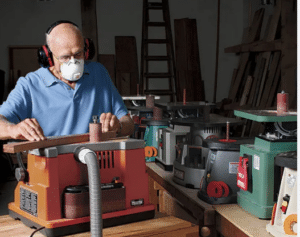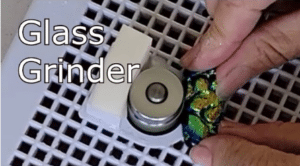A spindle sander is a tool that is commonly used in woodworking for sanding and shaping curved surfaces. However, some people have wondered if a spindle sander can be used for other purposes, such as grinding glass. While it is possible to use a spindle sander for glass grinding, it is not recommended.
The main reason why a spindle sander is not ideal for glass grinding is because the sanding drums that are used in the tool are not designed for this purpose. These drums are typically made of rubber and are coated with abrasive material, which is great for sanding wood but not for grinding glass. Additionally, the speed at which the spindle sander operates is not suitable for glass grinding, which requires a slower speed to prevent cracking or chipping of the glass.
Understanding Spindle Sanders

Spindle sanders are versatile woodworking tools that are designed to sand curved and contoured surfaces. They consist of a motor that drives a spindle, which is fitted with a sanding sleeve. The spindle rotates at high speed, and the sanding sleeve moves up and down, allowing the user to sand a variety of shapes and sizes.
Spindle sanders are commonly used for sanding the inside of curves, such as those found in chair legs, table legs, and other furniture components. They can also be used for sanding the edges of boards, such as those used for making picture frames and boxes.
Spindle sanders come in various sizes and shapes, ranging from small benchtop models to large floor-standing models. They can be powered by electricity or air, and some models even come with multiple spindles, allowing the user to sand multiple surfaces at once.
When using a spindle sander, it is important to select the correct sanding sleeve for the task at hand. Sanding sleeves come in various grits, ranging from coarse to fine, and selecting the right grit will ensure that the surface is sanded to the desired finish.
Overall, spindle sanders are an excellent tool for sanding curved and contoured surfaces. However, they are not designed for grinding glass or other hard materials. Attempting to use a spindle sander as a glass grinder could result in damage to the tool and potentially cause injury to the user.
Understanding Glass Grinders

Glass grinders are specialized tools that are used to shape and smooth glass surfaces. These tools come in various shapes and sizes, and they are designed to work with different types of glass. Glass grinders are commonly used in the glass art industry, but they can also be used for DIY projects and repairs.
When it comes to glass grinding, there are two main types of grinders: flat lap grinders and vertical wheel grinders. Flat lap grinders are designed to grind flat surfaces, while vertical wheel grinders are designed to grind curves and intricate shapes. Both types of grinders use diamond-coated grinding bits to grind and shape the glass.
Glass grinders are typically powered by electricity, and they come with a variety of features and accessories. Some grinders have adjustable speed settings, while others have water reservoirs to keep the grinding bit cool and lubricated. Additionally, some grinders come with different sizes and shapes of grinding bits to accommodate different types of glass and grinding needs.
Overall, glass grinders are essential tools for anyone working with glass. They allow for precise shaping and smoothing of glass surfaces, and they can be used for a variety of projects and applications.
Differences Between Spindle Sanders and Glass Grinders
Spindle sanders and glass grinders are two different tools, each designed for a specific purpose. While spindle sanders are used for sanding and shaping wood, glass grinders are used for grinding and shaping glass. Here are some of the key differences between the two tools:
Motor Power and Speed
Spindle sanders typically have more powerful motors than glass grinders. They also have variable speed controls, allowing users to adjust the speed of the sanding drum to suit the task at hand. Glass grinders, on the other hand, tend to have less powerful motors and fixed speed settings.
Abrasives
Spindle sanders use sanding drums with abrasive sleeves to sand and shape wood. These sleeves come in different grits, allowing users to choose the appropriate level of abrasiveness for the task at hand. Glass grinders, on the other hand, use diamond-coated grinding bits to grind and shape glass. These bits are available in different sizes and shapes, and can be used to create a variety of different finishes.
Work Surface
Spindle sanders typically have a flat work surface, with the sanding drum protruding from the top. This allows users to sand and shape flat surfaces, as well as curved edges and contours. Glass grinders, on the other hand, have a curved work surface, which allows users to grind and shape curved surfaces with ease.
Dust Collection
Spindle sanders often come with built-in dust collection systems, which help to keep the work area clean and free of debris. Glass grinders, on the other hand, do not typically have built-in dust collection systems, and users may need to wear a dust mask or use a separate dust collection system to keep the work area clean.
while spindle sanders and glass grinders may look similar at first glance, they are two very different tools designed for different tasks. While it may be possible to use a spindle sander as a glass grinder in a pinch, it is not recommended, as the two tools have different motor power, abrasives, work surfaces, and dust collection systems.
Using Spindle Sanders as Glass Grinders
Spindle sanders are versatile tools that can be used for various purposes, including sanding, shaping, and smoothing wood. However, some people have wondered if these machines can be used as glass grinders. In this section, we will explore the topic and provide information about the safety measures, effectiveness, and limitations of using spindle sanders as glass grinders.
Safety Measures
Using a spindle sander as a glass grinder requires caution and proper safety measures. It is essential to wear protective gear, such as goggles, gloves, and a dust mask, to prevent injuries and inhaling glass dust. The user should also ensure that the glass is securely held in place to avoid it from slipping or shattering.
Effectiveness
While spindle sanders can be used to grind glass, they are not the most effective tool for the job. Glass grinders have a specialized diamond-coated grinding wheel that is designed to grind glass precisely and smoothly. Spindle sanders, on the other hand, have a sanding drum that is not suitable for grinding glass. The abrasive surface of the sanding drum can cause the glass to chip, crack, or break, leading to an uneven finish.
Limitations
Using a spindle sander as a glass grinder has some limitations. The sanding drum may not be able to reach tight corners or edges, resulting in an uneven finish. The user may also need to change the sanding drum frequently to achieve the desired result, which can be time-consuming.
while it is possible to use a spindle sander as a glass grinder, it is not the most effective or efficient method. Glass grinders are designed specifically for grinding glass and offer a smoother and more precise finish. Therefore, it is recommended to use a glass grinder for this purpose to achieve the best results.
Alternative Methods for Grinding Glass
While a spindle sander may not be the best tool for grinding glass due to its design and intended use, there are alternative methods that can be used to achieve the desired result. Here are a few options:
1. Diamond Grinder
A diamond grinder is a specialized tool designed specifically for grinding and shaping glass. It uses a diamond-coated wheel to grind away the glass, leaving a smooth and polished surface. Diamond grinders come in a variety of sizes and shapes, and can be used for everything from small pieces of glass to larger projects like windows and mirrors.
2. Belt Sander
A belt sander can also be used to grind glass, although it is not as precise as a diamond grinder. The key is to use a very fine grit sandpaper, such as 220 or 320 grit, and to be very careful not to apply too much pressure. Belt sanders can be useful for removing sharp edges or rough spots on glass pieces.
3. Handheld Rotary Tool
A handheld rotary tool, such as a Dremel, can also be used to grind glass. Again, it is important to use a very fine grit sandpaper, and to be very careful not to apply too much pressure. Rotary tools can be useful for small, intricate pieces of glass, and can also be used for etching or engraving designs into the glass.
While a spindle sander may not be the best tool for grinding glass, there are alternative methods that can be used to achieve the desired result. By using a diamond grinder, belt sander, or handheld rotary tool, it is possible to grind and shape glass into a variety of shapes and sizes.
Final Words
In conclusion, while a spindle sander may seem like a viable option for grinding glass, it is not recommended. The spindle sander is designed for sanding wood and other materials, and its high-speed rotation can cause the glass to crack or shatter. Additionally, the spindle sander lacks the necessary cooling system to prevent the glass from overheating and cracking.
If you are looking for a glass grinder, it is best to invest in a dedicated glass grinder that has been specifically designed for that purpose. A glass grinder will have a slower rotation speed, a water cooling system, and a diamond-coated grinding wheel that is designed to grind and shape glass without damaging it.
While it may be tempting to try and use a spindle sander as a glass grinder, it is important to remember that doing so can be dangerous and may result in injury or damage to the glass. Instead, invest in a quality glass grinder that will provide you with the precision and control that you need to create beautiful glass pieces.
Reader Interactions